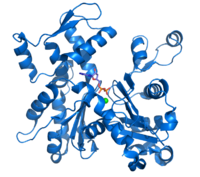
Photo from wikipedia
Cell-cell fusion is a frequent and essential event during development, and its dysregulation causes diseases ranging from infertility to muscle weakness. Fusing cells need to repeatedly remodel their plasma membrane… Click to show full abstract
Cell-cell fusion is a frequent and essential event during development, and its dysregulation causes diseases ranging from infertility to muscle weakness. Fusing cells need to repeatedly remodel their plasma membrane through orchestrated formation and disassembly of actin filaments, but how the dynamic reorganization of the cortical actin cytoskeleton is controlled is still poorly understood. Here, we identified a ubiquitin-dependent toggle switch that establishes reversible actin bundling during mammalian cell fusion. We found that EPS8-IRSp53 complexes stabilize cortical actin bundles at sites of cell contact to promote close membrane alignment. EPS8 monoubiquitylation by CUL3KCTD10 displaces EPS8-IRSp53 from membranes and counteracts actin bundling, a dual activity that restricts actin bundling to allow paired cells to progress with fusion. We conclude that cytoskeletal rearrangements during development are precisely controlled by ubiquitylation, raising the possibility of modulating the efficiency of cell-cell fusion for therapeutic benefit.
Journal Title: Developmental cell
Year Published: 2021
Link to full text (if available)
Share on Social Media: Sign Up to like & get
recommendations!